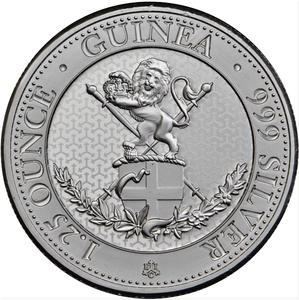Silver Ounce and Quarter 2021 Standing Lion Guinea, Coin from Saint Helena - detailed information
| ||||||||||||
Saint Helena is a small island in the South Atlantic Ocean which is part of the British overseas territory of Saint Helena, Ascension and Tristan da Cunha. The currency of the island is the Saint Helena pound, fixed at parity with the pound sterling. The island has authorised some private mints to issue coins under its jurisdiction, which come in a variety of sizes. Some of them are non-standard and/or one-off issues in silver, such as this one. This bullion silver coin denominated as £1.25 is part of the Guinea coin range by The East India Company. The guinea was once the most respected and internationally recognised coinage in the world. First issued in 1663 during the reign of King Charles II, the guinea gold coins went through various designs and were issued by England and its many overseas colonies for nearly 200 years. The gold coin was the first machine-coin gold piece from the Royal Mint and it would eventually become an international symbol of Great Britain's growing power and influence during the 17th and 18th centuries. | ||||||||||||
| ||||||||||||
| ||||||||||||
| ||||||||||||
| ||||||||||||
| ||||||||||||
| ||||||||||||
 |
| Royal Mint |
Saint Helena coins with historic Guinea and other designs include (ordered by year / metal / size / design):
- 8 g Gold Proof, Standing Lion Guinea 2013
- 8 g Gold Proof, Standing Lion Guinea 2015
- 4 g Gold Proof, Standing Lion Half Guinea 2015
- 2 g Gold Proof, Standing Lion Quarter Guinea 2015
- 1/4 oz Gold Bullion, Rose Crown Guinea 2018
- 1.25 oz Silver Bullion, Rose Crown Guinea 2018
- 1 oz Silver Bullion, Spade Guinea 2018
- 1 oz Silver Bullion, Spade Guinea 2019
- 8.4 g Gold Proof, Military Guinea 2020
- 7.98 g Sovereign, Gold Proof, Spade Guinea 2020
- 1/4 oz Gold Bullion, Rose Crown Guinea 2020
- 1/4 oz Gold Bullion, Sceptre Guinea 2020
- 4.2 g Gold Proof, Spade Half Guinea 2020
- 2.1 g Gold Proof, Rose Crown Quarter Guinea 2020
- 1.25 oz Silver Bullion, Rose Crown Guinea 2020
- 1.25 oz Silver Bullion, Sceptre Guinea 2020
- 1/10 oz Silver Bullion, Spade Guinea 2020
- 1/4 oz Gold Bullion, Spade Guinea 2021
- 1/4 oz Gold Bullion, Rose Crown Guinea 2021
- 1/4 oz Gold Bullion, Sceptre Guinea 2021
- 1/3 oz Platinum Bullion, Rose Crown Guinea 2021
- 1.25 oz Silver Bullion, Seated Britannia 2021
- 1.25 oz Silver Bullion, Rose Crown Guinea 2021
- 1.25 oz Silver Bullion, Standing Lion Guinea 2021
- 1.25 oz Silver Bullion, Sceptre Guinea 2021
- 1.25 oz Silver Bullion, Military Guinea 2021
- 1 oz Silver Bullion, Standing Britannia 2021
- 1/10 oz Silver Bullion, Spade Guinea 2021
- 1/4 oz Gold Bullion, Rose Crown Guinea 2022
- 1/4 oz Gold Bullion, Half Crown 2022
- 1.25 oz Silver Bullion, Rose Crown Guinea 2022
- 1.25 oz Silver Bullion, Standing Lion Guinea 2022
- 1.25 oz Silver Bullion, Sceptre Guinea 2022
- 1.25 oz Silver Bullion, Spade Guinea 2022
- 1.25 oz Silver Bullion, Half Crown 2022
- 1 oz Silver Bullion, Military Guinea 2022
- 1/10 oz Silver Bullion, Spade Guinea 2022
- 42 g Gold Proof, Spade Five Guineas 2023
- 16.8 g Gold Proof, Spade Two Guineas 2023
- 8.4 g Gold Proof, Spade Guinea 2023
- 8.4 g Gold Proof, Standing Lion Guinea 2023
- 4.2 g Gold Proof, Spade Guinea 2023
- 2.1 g Gold Proof, Spade Half Guinea 2023
- 1/10 oz Silver Bullion, Spade Guinea 2023
- 42 g Gold Proof, Cruciform and Sceptre Five Guineas 2024
- 16.8 g Gold Proof, Cruciform and Sceptre Two Guineas 2024
- 8.4 g Gold Proof, Cruciform and Sceptre Guinea 2024
- 8.4 g Gold Proof, Standing Lion Guinea 2024
- 1/4 oz Gold Bullion, Queen Victoria Seal 2024
- 4.2 g Gold Proof, Cruciform and Sceptre Half Guinea 2024
- 2.1 g Gold Proof, Cruciform and Sceptre Quarter Guinea 2024
- 0.51 g Gold Proof, Cruciform and Sceptre Sixteenth Guinea 2024
- 1.25 oz Silver Bullion, Queen Victoria Seal 2024
 |
| The Definitive Guide to Australian Silver Coins |
| Country | Saint Helena |
|---|---|
| Currency | Saint Helena Pound |
| Coin Type | Silver Other Sizes |
| Issued | 2021 |
| Monarch | Queen Elizabeth II |
| Effigy | Queen Elizabeth II - Third Portrait, by Raphael Maklouf |
| Face Value | 1.25 (x Pound) |
| Mintage | unknown |
| Current | Yes |
| Material | 0.999 Silver |
| Technology | Milled (machine-made) |
| Shape | Round |
| Orientation | Medal Alignment (Axis 0) |
| Size | 38.3000 mm |
| Thickness | 3.600 mm |
| Mass | 38.8750 g |
| OCC ID | DKLM-OMKC-XBKR-ONZB |


 Search for Saint Helena: Silver Ounce and Quarter 2021 Standing Lion Guinea on eBay
Search for Saint Helena: Silver Ounce and Quarter 2021 Standing Lion Guinea on eBay 

